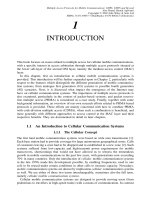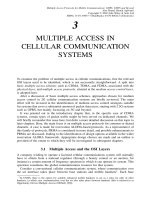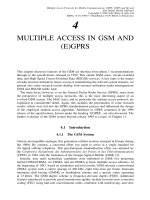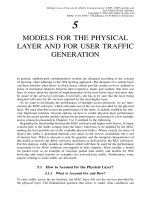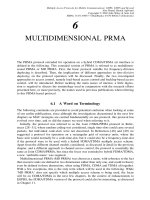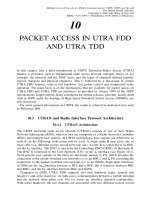Nhiều giao thức truy cập đối với truyền thông di động P7
Bạn đang xem bản rút gọn của tài liệu. Xem và tải ngay bản đầy đủ của tài liệu tại đây (303.17 KB, 32 trang )
Multiple Access Protocols for Mobile Communications: GPRS, UMTS and Beyond
Alex Brand, Hamid Aghvami
Copyright
2002 John Wiley & Sons Ltd
ISBNs: 0-471-49877-7 (Hardback); 0-470-84622-4 (Electronic)
7
MD PRMA WITH LOAD-BASED
ACCESS CONTROL
Chapter 5 provided descriptions of channel and traffic models used for investigations on
the MD PRMA protocol, which was defined in detail in Chapter 6. Starting with this
chapter, and continuing in Chapters 8 and 9, the outcomes of our research efforts on MD
PRMA will be discussed.
In this chapter, the focus is on load-based access control (for MD PRMA), a technique
adopted to protect reservation-mode users from multiple access interference generated by
contending users. Only voice traffic is considered. We are investigating an interference-
limited scenario, where code-slots are not distinguished, and random coding is assumed
instead, such that ‘classical’ code-collisions cannot occur. However, users may still suffer
‘collisions’ due to excessive MAI, which will cause packet erasure. With access control,
the overall packet-loss probability P
loss
is composed of the packet-dropping ratio P
drop
and the packet-erasure rate P
pe
. Load-based access control is applied to trade off packet
dropping against packet erasure in a manner which minimises P
loss
.
To assess the benefits of load-based access control through so-called channel access
functions (CAFs), several benchmarks are introduced. After a section defining the system
considered, both analytical and simulation results for the first benchmark, a random access
protocol, are presented. The analysis is expanded to underpin some of the comments
made in the introductory chapter of this book on multiplexing efficiency. Other bench-
marks include one used as a reference to assess multiplexing efficiency, and an ideal
backlog-based access control scheme. Following considerations on channel access func-
tions used for load-based access control, performances of the different schemes considered
are compared for various scenarios. This includes a study of the impact of power control
errors and the choice of the spreading factor.
7.1 System Definition and Choice of Design Parameters
7.1.1 System Definition and Simulation Approach
MD PRMA for frequency division duplexing as defined in Section 6.2 is considered,
assuming immediate acknowledgements and using load-based access control as described
in Section 6.4. Physical layer performance is accounted for assuming random coding and
applying the standard Gaussian approximation to assess the error performance, as outlined
in Section 5.2. When intercell interference is considered, all cells are assumed to be
280
7 MD PRMA WITH LOAD-BASED ACCESS CONTROL
equally loaded, that is, K in Equation (5.16) is the average load per time-slot experienced
in the test cell, as defined below, and
I
intercell
is taken to be 0.37 and 0.75, for values of the
pathloss coefficient γ
pl
of 4 and 3 respectively. Code-slots are not considered. Therefore, in
Subsection 6.2.3, the specific considerations provided for the random-coding case apply.
In other words, we are considering a purely interference-limited system, where, however,
instantaneous interference levels are only considered for interference generated within the
test cell, while intercell interference is assumed to be constant at its average level. To
assess the benefit of load-based access control, MD PRMA performance is compared with
that of various benchmarks, which are defined below.
The only traffic considered in this chapter is packet-voice traffic, using the two-state
voice model specified in Section 5.5 with parameters D
spurt
= 1s and D
gap
= 1.35 s,
which results in a voice activity factor α
v
= 0.426. The number of conversations M
supported simultaneously determines the system load. P
loss
performance as a function of
M is of interest here, and particularly, M
0.01
and M
0.001
, the number of conversations
which can be supported at tolerated maximum P
loss
values, (P
loss
)
max
, of 1% and 0.1%,
respectively. A static scenario is considered, where P
loss
is established as a function of
M,andM remains fixed over the relevant period of observation. Therefore, the average
number of users per time-slot
K can be obtained through
K =
M · α
v
N
.(7.1)
Simulations were performed using a commercial, event-driven and object-oriented tool
for network simulations. Each simulation-run with fixed M covered 1000 s conversation
time. Where required, several simulation-runs were performed for the same value of M,
in which case the P
loss
reported is the averaged result over these simulation-runs.
7.1.2 Choice of Design Parameters
The starting point for the choice of design parameters is to be found in Reference [146].
In this reference, a voice source rate R
s
of 8 kb/s and a frame length D
tf
of 20 ms are
considered, yielding 160 information bits per packet
1
, to which 64 header bits are added.
With a PRMA channel rate R
p
of 224 kbit/s, neglecting guard periods, a slot duration
D
slot
of 1 ms is required to accommodate a packet. A frame is therefore composed of
N = 20 time-slots. The dropping delay threshold D
max
issetto20ms,whichishalfthe
value considered in Reference [146]. This is to keep the total transfer delay low, to which
also other sources of delay contribute, such as framing delay and processing delay.
It remains to specify the FEC code-rate r
c
and the spreading factor X. In Section 5.2,
the optimum value for r
c
was established for packets with 224 message bits, applying the
Gilbert–Varshamov bound. It was found that, irrespective of X, the bandwidth-normalised
throughput was maximised when r
c
was between 0.4 and 0.6. A suitable BCH code with
a code-rate in this range of values is the (511, 229, 38) BCH code. It supports five more
message bits than required (they will be attributed to the header), and has a code-rate
r
c
of 0.45. With this choice, R
p
increases to 229 kbit/s before error coding, while the
channel-rate after error-coding R
ec
is 511 kbit/s. Interleaving is not applied, every packet
1
In other Goodman publications, such as References [8] and [142], the voice source rate assumed was 32 kb/s,
which is rather high for a basic voice service in cellular systems.
7.2 THE RANDOM ACCESS PROTOCOL AS A BENCHMARK
281
Table 7.1 Parameters relevant for the physical layer, protocol operation and traffic models
Description Symbol Parameter Value
TDMA Frame Duration D
tf
20 ms
Time-Slots per Frame N 20
Message bits per Packet B 160 information bits + 69 header bits
Channel-Rate before Error-Coding R
p
229 kbit/s
Channel-Rate after Error-Coding R
ec
511 kbit/s
Chip-Rate R
c
3.577 Mchip/s
Dropping Delay Threshold D
max
20 ms
Voice Terminal Source-Rate R
s
8 kbit/s
Mean Talk Gap Duration D
gap
1.35 s
Mean Talk Spurt Duration D
spurt
1s
is separately error-coded, and contention and reservation-mode packets have the same
packet format. This also implies that contention packets contain the same amount of user
data as those sent on reserved resources. No dedicated request bursts are generated.
In order to limit computer resource requirements for simulations, a rather low spreading
factor of X = 7 was chosen when we started our investigations on PRMA-based protocols
back in 1994. The resulting chip-rate R
c
of 3.577 Mchip/s is surprisingly close to the
one having been chosen for UTRA. Most of the results presented in the following are
for X = 7. If larger spreading factors are considered, this is explicitly mentioned. The
complete set of parameters used is listed in Table 7.1.
7.2 The Random Access Protocol as a Benchmark
7.2.1 Description of the Random Access Protocol
In References [28–31] we established the benefits of load-based access control through
a performance comparison with what was referred to there as random access CDMA.
Strictly speaking, the name ‘random access CDMA’ is somewhat misleading, since the
same hybrid CDMA/TDMA channel structure as in MD PRMA is used. A more generic
name will therefore be used for this protocol; it will be referred to here as random access
protocol (RAP). In RAP, every user may access the channel at will. In other words, the
access permission probability p is always set to one. For a voice user, this simply means
that the next time-slot after the arrival of a talk spurt will be accessed. In Reference [31],
it was assumed that a voice terminal needed to retransmit the first packet of a spurt until
it was successfully received and acknowledged by the base station. This can be viewed as
MD PRMA with p = 1. Here, in order to have completely unconstrained channel access,
packets are never retransmitted, and the time-slot number used for all packets in a spurt
depends only on the arrival instance of the first packet in that spurt. Therefore, P
drop
is
always zero, and the P
loss
performance is entirely determined by P
pe
.
282
7 MD PRMA WITH LOAD-BASED ACCESS CONTROL
7.2.2 Analysis of the Random Access Protocol
According to Section 5.5, the steady-state distribution for the number of simultaneously
active terminals v given M voice sources is
Pr{V = v}=P
V
(v) =
M
v
· α
v
v
· (1 − α
v
)
M−v
(7.2)
with mean
V = M · α
v
.Thesev simultaneously active users will be distributed in some
fashion over the N available time-slots. With completely unconstrained access as discussed
above, there is no reason to expect that some time-slots are more likely to be chosen by
any one of the users than others are. Furthermore, with exponentially distributed spurt and
gap duration, any particular user will choose time-slots for successive spurts independently
of each other. It can therefore be assumed that each slot in a TDMA frame is chosen with
equal likelihood, i.e. P
slot
= 1/N. The probability of k users accessing a slot conditioned
on v active users is then
Pr{K = k|V = v}=P
K|V
(k|v) =
v
k
· P
k
slot
· (1 − P
slot
)
v−k
,(7.3)
and the unconditional probability can be calculated through
Pr{K = k}=P
K
(k) =
M
v=k
P
V
(v) · P
K|V
(k|v). (7.4)
Note that the summation starts from k, since in order that k users access a certain
time-slot, there must be at least k users active in total.
Finally, P
loss
can easily be calculated according to
P
loss
=
1
K
M
k=0
k · P
K
(k) · P
pe
[k],(7.5)
with
K from Equation (7.1). To establish the packet erasure probability P
pe
[k], depending
on the circumstances considered, Equations (5.7) and (5.3) together with either Equa-
tion (5.6) or Equation (5.16) are used
2
. Alternatively, Equation (5.20) may be used.
The steady-state distribution (Equation (7.2)) is a binomial distribution with parame-
ters M and α
v
. The Poisson distribution with mean V = M · α
v
is a good approximation
of the binomial distribution, provided that α
v
1andM large (e.g. α
v
< 0.05 and
M>10). The first condition must hold for the variance of the binomial distribution,
M · α
v
· (1 − α
v
), to match roughly that of the Poisson distribution, V . Here, α
v
is signif-
icantly larger than 0.05, and thus, the variances of the two distributions cannot match,
irrespective of M. Assume for now all the same, that Equation (7.2) can be approximated
by a Poisson distribution with mean
V . In this case, since every slot is selected indepen-
dently with probability P
slot
, the probability distribution per slot is again Poisson with
2
The attentive reader will have noticed that upper case ‘K’ was used for the number of users per time-slot
in Chapter 5, while ‘k’ was used as an index for a particular user out of these K users. For consistency of
notation in this chapter, ‘k’ is here the number of users per time-slot, and ‘K’ the respective random variable.
Instead of
K
, we can write P
K
(k) for the probability distribution of this random variable.
7.2 THE RANDOM ACCESS PROTOCOL AS A BENCHMARK
283
mean V/N= K owing to the ‘splitting property’ of the Poisson process discussed in
Section 6.5. Therefore,
P
K
(k) =
K
k
e
−K
k!
.(7.6)
This approximation is useful for the discussion on multiplexing efficiency provided in
Subsection 7.2.4. Its accuracy is assessed below.
7.2.3 Analysis vs Simulation Results
In Figure 7.1, P
loss
values resulting with the random access protocol are reported as
a function of M for two cases, namely an isolated test cell and a test cell in a cellular
environment, in both cases assuming perfect power control. In the single-cell case, there is
no intercell interference, and Equation (5.6) is used for the average SNR which determines
P
pe
[k]. For the results shown for the cellular environment, a pathloss coefficient γ
pl
of 4 is
assumed, and average intercell interference is accounted for by using Equation (5.16), with
I
intercell
= 0.37, instead of Equation (5.6). The curves with markers represent simulation
results, whereas the solid and the dashed curves refer to analytical results with the binomial
steady-state distribution according to Equation (7.2) and the Poisson approximation for
the steady-state distribution respectively.
Two conclusions can be drawn from this figure. Firstly, judging from the P
loss
values
reported, the Poisson approximation models the P
loss
performance obtained with the
binomial distribution quite well for large values of M, regardless of the variance
mismatch. With decreasing M, however, the gap between the P
loss
values calculated
widens. Secondly, in general a very good agreement between analysis and simulation
results can be observed. Normally, even simulation results obtained from individual 1000 s
simulation-runs closely match the analytical results, although most points shown in the
0.0001
0.001
0.01
0.1
90 110 130 150 170 190 210 230 250
Simultaneous conversations
M
Packet loss ratio
P
loss
Simulation
Binomial
Poisson
Perfect power control
spreading factor
X
= 7
Cellular environment,
g
pl
= 4
Single cell
Figure 7.1 Performance of the random access protocol with perfect power control
284
7 MD PRMA WITH LOAD-BASED ACCESS CONTROL
simulated curves represent results averaged over several simulation-runs. As a result of
this averaging, fairly smooth curves were obtained, but in rare occasions such as M = 130
in the single-cell case, even averaging over more than 50 simulation results did not allow
the curve to smooth out perfectly.
Figure 7.2 shows equivalent results for the case when power control errors are accounted
for through Equation (5.20). Here, due to the flatter P
pe
[k]-slopes, the errors made with
the Poisson approximation of the binomial steady-state distribution have a much smaller
impact on the calculated P
loss
values than in the case considered above. Correspondingly,
the two analytical curves almost match even for small values of M. Again, a very good
agreement between analytical and simulation results can be observed, which validates the
simulation platform. Figure 7.3, showing only simulation results, summarises all cases
considered for X = 7. Note that the impact of the intercell interference decreases with
increasing error variance (which is partially due to the fact that fluctuations of the inter-
cell interference level are not captured here). The two curves shown for σ
2
pc
= 2dB(or
σ
pc
= 1.41 dB) even meet below a packet-loss ratio of 0.1%. A more detailed discus-
sion of the performance degradation due to power control errors will be provided in
Section 7.6.
For completeness, it is reported that simulations were also carried out for a spreading
factor X = 15, obtaining similar agreement between simulation and analytical results as
in the cases illustrated here.
7.2.4 On Multiplexing Efficiency with RAP
In Section 1.4, we claimed that the statistical multiplexing gain depended essentially on
the standard deviation normalised to the mean of simultaneously active users (or almost
equivalently: the standard deviation of the multiple access interference or MAI). In the
following, this claim is first substantiated and, based on this, further observations on
0.0001
0.001
0.01
0.1
20 40 60 80 100 120 140 160 180 200
Simultaneous conversations
M
Packet loss ratio
P
loss
Simulation
Binomial
Poisson
Lognormal power control errors
spreading factor
X
= 7
isolated cell
s
pc
= 1.41 dB
s
pc
= 1 dB
Figure 7.2 Performance of RAP when accounting for power control errors
7.2 THE RANDOM ACCESS PROTOCOL AS A BENCHMARK
285
0.0001
0.001
0.01
0.1
10 50 90 130 170 210 250
Simultaneous conversations
M
Packet loss ratio
P
loss
Spreading factor
X
= 7
s
pc
= 0 dB
s
pc
= 1 dB
s
pc
= 1.41 dB
g
pl
= 4, s
pc
= 0 dB
g
pl
= 4, s
pc
= 1 dB
g
pl
= 4, s
pc
= 1.41 dB
g
pl
= 3, s
pc
= 0 dB
Figure 7.3 Simulation results for RAP obtained with different values for σ
pc
, both for an isolated
cell and two cellular scenarios with γ
pl
= 4and3
multiplexing efficiency with pure CDMA and hybrid CDMA/TDMA air interfaces are
provided.
For simplicity, assume a physical layer on which all packets are transmitted success-
fully, if no more than K
pe max
users access the channel simultaneously, and otherwise, all
packets are erased. In other words, P
pe
[k] is approximated by a step-function,
P
pe
[k] =
0,k≤ K
pe max
1,k>K
pe max
,
(7.7)
and K
pe max
represents the number of resource units available.
With P
K
(k) describing the distribution of the random variable K, and with P
pe
[k]as
above,
P
loss
=
1
K
M
k=K
pe max
+1
k · P
K
(k). (7.8)
The appropriately weighted and normalised tail of the distribution of K, shaded in
Figure 7.4 provided for illustration, determines the packet-loss ratio. Restricting the focus
to bell-shaped distributions, at a given offset between K
pe max
and mean K of this distri-
bution, it is obvious that the larger the standard deviation of K, σ
K
,thelargerP
loss
.The
more interesting question to ask is what kind of offset needs to be respected in order not
to exceed a certain (P
loss
)
max
. Write this offset as a multiple of σ
K
,
K
pe max
− K = c
offset
· σ
K
,(7.9)
286
7 MD PRMA WITH LOAD-BASED ACCESS CONTROL
0
0.01
0.02
0.03
0.04
0.05
0.06
007
15 20 25 30 35 40
Users
K
per time-slot
45 50 55 60 65
P
K
(
k
)
K
pe
max
K
C
offset
.s
K
s
K
Figure 7.4 Illustration of K and K
pe max
when K is Poisson with mean K = 40
as shown in Figure 7.4. Next, define multiplexing efficiency η
mux
as the ratio of K over
K
pe max
, which is the normalised resource utilisation. Using Equation (7.9),
η
mux
=
c
offset
· σ
K
K
+ 1
−1
.(7.10)
If c
offset
were a constant, we could indeed claim that the multiplexing efficiency only
depends on the normalised standard deviation σ
K
/K. The smaller its value, the larger
the multiplexing efficiency. But is c
offset
constant? It would almost be, if the shape of the
tail of the distribution of K were fully described by σ
K
(as for instance with a normal
distribution)
3
. Since it has just been found that P
loss
performance of RAP is modelled
accurately if K is assumed to be Poisson distributed, this distribution will be used in
the following. If we ignore the fact that a continuous distribution is being compared
with a discrete distribution, when
K 0, the Poisson distribution resembles the normal
distribution. In particular, it is nicely bell-shaped, as shown in Figure 7.4, although not
completely symmetric with respect to
K. However, there is only one degree of freedom:
the Poisson distribution is entirely specified by its mean
K, and the variance is equal to
the mean, thus σ
K
=
√
K.
Figure 7.5 shows c
offset
as a function of K for a Poisson distribution. Individual points
in this graph were obtained by fixing K
pe max
, imposing (P
loss
)
max
= 1%, and calcu-
lating the maximum value of
K which is admissible to meet this P
loss
requirement,
as determined through Equation (7.8) together with Equation (7.6). As expected, c
offset
is almost constant for K above 20, while there are somewhat stronger fluctuations
for lower values of
K, where the Poisson distribution loses its bell shape. Since σ
K
increases less than linearly with K, η
mux
increases with increasing K (the fact that
3
Because of inevitable distortion effects due to the weighting and normalisation in Equation (7.8), c
offset
will
fluctuate slightly, even if a normal distribution is considered.
7.2 THE RANDOM ACCESS PROTOCOL AS A BENCHMARK
287
3.5
3
2.5
2
01020304050
Mean number of users
K
per time-slot
c
offset
60 70 80 90 100
Figure 7.5 c
offset
as a function of K
c
offset
decreases with increasing K further amplifies this effect). K can obviously only be
increased, if K
pe max
is increased as well, that is, more bandwidth or resources must be
provided.
Summarising, the multiplexing efficiency increases with increasing size of the popula-
tion multiplexed onto a common resource. This is very similar to the so-called trunking
efficiency in blocking-limited circuit-switched systems discussed in Section 4.6: the larger
the number of channels provided, the higher the average channel utilisation at a given
admissible blocking level.
Next, we need to ask how the relevant common resource is determined. In Section 1.4,
we stated that the relevant resource for multiplexing was an entire carrier in wideband
CDMA, but only a time-slot in hybrid CDMA/TDMA with unconstrained channel access.
Consider a hybrid CDMA/TDMA system with N time-slots and K
pe max
= E,andawide-
band CDMA system with an equivalent amount of resources, but no time-slots (or rather,
only one ‘time-slot’ per frame), i.e. K
pe max
= N · E. In the latter case, the steady-state
distribution of the total number of users on the carrier being considered, which is approx-
imately Poisson with mean
V
C
, determines the packet-loss probability. Therefore, the
trunking efficiency is determined by the total number of users. In the hybrid case, as just
seen, the relevant distribution is the distribution per time-slot with mean
V
CT
/N, thus
the trunking efficiency is determined by the average number of users accessing a single
time-slot. If the total amount of resources is the same as in the pure CDMA case, the
trunking efficiency will be lower and, thus, the hybrid solution will support fewer users
at a given (P
loss
)
max
,i.e.V
CT
< V
C
.
For quantitative considerations on these matters, based on Gaussian approximations for
physical layer modelling rather than the simple step function as per Equation (7.7), refer
also to Section 7.6. These findings would suggest that a pure CDMA air interface is a
better choice than a hybrid CDMA/TDMA air interface from a pure multiplexing point
of view. However, if the load is balanced out between time-slots through access control,
the relevant population becomes the total number of terminals admitted to this carrier in
the hybrid CDMA/TDMA case as well. This is shown below.
288
7 MD PRMA WITH LOAD-BASED ACCESS CONTROL
7.3 Three More Benchmarks
7.3.1 The Minimum-Variance Benchmark
Suppose M simultaneous conversations are to be supported on N time-slots, such that
the average load per slot amounts to
K = M · α
v
/N packets. Assume further that it is
possible to schedule packets perfectly on the uplink, that is, the base station could have
full control over how many users access any given time-slot, through whatever means
may be necessary. Consider the case where the base station schedules either k
1
=K
or k
2
=K packets per slot (in other words, k
1
and k
2
are the two consecutive integers
embracing
K). Of all possible discrete distributions for K with mean K, this is the one
with minimum variance.
In Reference [30], to find the highest theoretically possible number of conversations
which can be supported at a given (P
loss
)
max
, the analysis focussed on such minimum-
variance distributions, for which Equation (7.5) can be rewritten as
P
loss
=
P
K
(k
1
) · k
1
· P
pe
[k
1
] + P
K
(k
2
) · k
2
· P
pe
[k
2
]
P
K
(k
1
) · k
1
+ P
K
(k
2
) · k
2
.(7.11)
In the above equation, the denominator is the mean
K or expectation E[K]ofthe
distribution of K.SinceP
K
(k
1
) + P
K
(k
2
) = 1, it can easily be shown that
P
K
(k
1
) =
K − k
2
k
1
− k
2
.(7.12)
P
loss
(M) can now be calculated using Equation (7.1) to establish K, then Equa-
tions (7.12) and (7.11) with P
K
(k
2
) = 1 − P
K
(k
1
). Note that these formulas imply perfect
statistical multiplexing. In other words, it is assumed that arbitrary distributions of K can
be shaped by scheduling and thus delaying packets as necessary, without having to drop
packets.
We claimed in Reference [30] that M
x
found at a given (P
loss
)
max
of x through the
formulas above is a strict upper limit for M
x
, and this benchmark was referred to as
perfect scheduling. While we still believe that it will be rather difficult to exceed M
x
with any other distribution than this minimum-variance distribution for the typical P
pe
[k]
curves found in Chapter 5, which are the ones of interest here, we have invested no
further efforts to prove this conjecture. On the other hand, if P
pe
[k] is approximated
by the step-function (7.7), the distribution maximising M
x
at a (P
loss
)
max
of x is not
the distribution considered above with minimum variance, as shown in Reference [61,
Appendix C]. Since ‘perfect scheduling’ may not only refer to the ability of the base
station to schedule precisely the wanted number of packets in each time-slot, but could
potentially also imply an optimum distribution for K, caution suggests that this benchmark
should be referred to in the following as the minimum-variance benchmark (MVB) rather
than the ‘perfect-scheduling benchmark’.
Throughout the remainder of this chapter, the packet erasure rate P
pe
[k] will be model-
led by Gaussian approximations and random coding is assumed, such that the number of
code-slots E per time-slot is in theory unlimited. Equation (6.1) given in Subsection 6.2.8
can therefore not be used to assess multiplexing efficiency, since the number of available
resource units is not clearly specified. However, U = N ·
K can be used instead of N · E
7.3 THREE MORE BENCHMARKS
289
for the number of available resource units in Equation (6.1) with K obtained through
MVB at the considered value for (P
loss
)
max
. In other words, to assess the multiplexing
efficiency achieved with load-based access control relative to (what we believe to be)
perfect statistical multiplexing, the M
0.01
or M
0.001
values obtained thereby will be related
simply to the respective numbers obtained with MVB.
7.3.1.1 Accounting for Packet Dropping
While MVB provides us with a tool to assess multiplexing efficiency, it is not suitable for
assessing the quality of access control in MD PRMA. Even with the perfect multiple access
protocol, that is, with perfect scheduling, if the service considered is delay constrained,
packet dropping will necessarily occur, unless one is prepared to schedule more packets
than the channel can carry reliably, thereby accepting increased P
pe
. It would therefore
be desirable to extend MVB in a manner that allows packet dropping to be accounted
for. Such a benchmark, which will be referred to as MVB with dropping (MVBwd), is
derived in the following. Assume that the scheduling is carried out frame-wise, and in
every frame in which the number of active users v exceeds the number of resource units
U =
K · N, v − U packets are dropped.
This is nearly, but not exactly equivalent to imposing a delay threshold D
max
of one
frame, as considered in this chapter for MD PRMA. The dropping probability can then
be calculated according to
P
drop
=
1
V
M
v=U+1
(v − U)P
V
(v), (7.13)
with P
V
(v) from Equation (7.2) and V = M · α
v
. In this context, Equation (7.11) is used
to calculate the packet erasure rate P
pe
instead of the total loss rate P
loss
,i.e.
P
pe
=
P
K
(k
1
) · k
1
· P
pe
[k
1
] + P
K
(k
2
) · k
2
· P
pe
[k
2
]
P
K
(k
1
) · k
1
+ P
K
(k
2
) · k
2
.(7.14)
The task is now to find an optimum trade-off between P
pe
and P
drop
using Equa-
tions (7.12) to (7.14), in order to maximise M at a given (P
loss
)
max
. As a first step, over all
U for which P
pe
<(P
loss
)
max
according to Equation (7.14), find the largest M for which
P
drop
obtained through Equation (7.13) does not exceed (P
drop
)
max
= (P
loss
)
max
− P
pe
.
Since statistical multiplexing is not perfect, on average only M · α
v
<U resource units
will carry packets, such that P
pe
obtained with Equation (7.14) is conservative, or in other
words, the (P
drop
)
max
-limit used for Equation (7.13) is unnecessarily low. M maximised
over U obtained in this manner is therefore referred to as worst-case MVBwd in the
following.
To refine this benchmark, an iterative approach is adopted, where in an alternating
fashion, P
pe
is adapted based on the actual load M, and Equation (7.13) is used to update
M based on the new (P
drop
)
max
. To establish the correct load distribution needed for
the calculation of P
pe
, some further elaboration of the scheduling algorithm is required.
Assume the base station knows the active number of users v at the beginning of a frame.
If v>U, U packets are scheduled according to MVB, and the remaining packets are
dropped, thus the mean number of packets per time-slot is in this frame
K
f
= U/N,
i.e. the same as
K before. Additionally, if v ≤ U , in which case no packet is dropped,
290
7 MD PRMA WITH LOAD-BASED ACCESS CONTROL
the base station is assumed to carry out minimum-variance scheduling on the basis of v
packets, with
K
f
= v/N. Now, in a somewhat ugly fashion, P
pe
can be written as
P
pe
=
U−1
v=1
P
V
(v)
v/N
v/N − k
2
k
1
− k
2
· k
1
· P
pe
[k
1
] +
k
1
− v/N
k
1
− k
2
· k
2
· P
pe
[k
2
]
+
M
v=U
P
V
(v)
U/N
U/N − k
2
k
1
− k
2
· k
1
· P
pe
[k
1
] +
k
1
− U/N
k
1
− k
2
· k
2
· P
pe
[k
2
]
(7.15)
with k
1
=K
f
and k
2
=K
f
,whereK
f
= v/N for v ≤ U ,otherwiseK
f
= U/N.
P
V
(v) is obtained through Equation (7.2).
In summary, for a given U (and thus a given
K), first P
pe
is calculated according
to Equation (7.14), next (provided that P
pe
≤ (P
loss
)
max
)thelargestM which satisfies
P
drop
≤ (P
drop
)
max
= (P
loss
)
max
− P
pe
using Equation (7.13), then P
pe
is updated through
Equation (7.15), and then Equations (7.13) and (7.15) are applied in an alternating fashion,
until M settles. Maximising over U , the optimum trade-off between P
pe
and P
drop
can be
found for any imposed (P
loss
)
max
.
Figure 7.6 juxtaposes MVB, worst-case MVB with dropping, and MVB with dropping
after several iterations. Calculations were carried out for an isolated cell, assuming perfect
power control. Towards large values of M, the gap between the worst-case curve and
that for plain MVB becomes smaller, which is due to increased multiplexing efficiency
at high load. The MVBwd-curve obtained after several iterations lies in-between these
two curves, as expected. A quick comparison with results for RAP (already shown in
Figure 7.1) makes it immediately clear that uncontrolled channel access is not advisable
in the scenario considered.
RAP
MVBwd, worst case
MVBwd
MVB
X
= 7, isolated cell
1.0E-1
1.0E-2
1.0E-3
1.0E-4
100 140 180 220 260
Simultaneous conversations
M
Packet loss ratio
P
loss
300 340 380 420
Figure 7.6 Comparison of MVB performance with and without dropping with that of the random
access protocol
